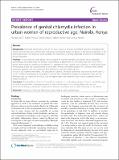Files in this item
Prevalence of genital chlamydia infection in urban women of reproductive age, Nairobi, Kenya
Item metadata
| dc.contributor.author | Kohli, Ruchika | |
| dc.contributor.author | Konya, Walter P. | |
| dc.contributor.author | Obura, Timona | |
| dc.contributor.author | Stones, William | |
| dc.contributor.author | Revathi, Gunturu | |
| dc.date.accessioned | 2016-09-27T15:30:18Z | |
| dc.date.available | 2016-09-27T15:30:18Z | |
| dc.date.issued | 2013-02-04 | |
| dc.identifier | 153953027 | |
| dc.identifier | 94c99c64-9590-4804-a025-889757d9535a | |
| dc.identifier | 84873105598 | |
| dc.identifier.citation | Kohli , R , Konya , W P , Obura , T , Stones , W & Revathi , G 2013 , ' Prevalence of genital chlamydia infection in urban women of reproductive age, Nairobi, Kenya ' , BMC Research Notes , vol. 6 , 44 . https://doi.org/10.1186/1756-0500-6-44 | en |
| dc.identifier.uri | https://hdl.handle.net/10023/9563 | |
| dc.description.abstract | Background: Chlamydia trachomatis is one of the major causes of sexually transmitted infections throughout the world. Most infections are asymptomatic and remain undetected. Burden of disease in the Kenyan population is not well characterised. This study was done to define the prevalence of genital Chlamydia infection in a representative female population. Findings: A cross-sectional study design was employed. All women attending out-patient clinics (antenatal, gynaecology, family planning) and accident and emergency departments at two study sites over a five month period were invited to consent to completion of a questionnaire and vaginal swab collection. A rapid point-of-care immunoassay based test was performed on the swabs. Women who tested positive for Chlamydia were offered treatment, together with their partner(s), and advised to come for a follow-up test. A total of 300 women were tested. The prevalence of genital Chlamydia trachomatis was found to be 6% (95% CI 3.31% - 8.69%). The prevalence was higher in women who represented a higher socioeconomic level, but this difference was not significant (p=0.061). Use of vaginal swabs was observed to be a more acceptable form of sample collection. Conclusion: The prevalence of genital Chlamydia is significant in our female population. There is a justifiable need to institute opportunistic screening programs to reduce the burden of this disease. Rapid and low cost point-of-care testing as a potential component of sexually transmitted infection (STI) screening can be utilised. | |
| dc.format.extent | 5 | |
| dc.format.extent | 338138 | |
| dc.language.iso | eng | |
| dc.relation.ispartof | BMC Research Notes | en |
| dc.rights | © Kohli et al.; licensee BioMed Central Ltd. 2013. This article is published under license to BioMed Central Ltd. This is an Open Access article distributed under the terms of the Creative Commons Attribution License (http://creativecommons.org/licenses/by/2.0), which permits unrestricted use, distribution, and reproduction in any medium, provided the original work is properly cited. | en |
| dc.subject | Prevalence | en |
| dc.subject | Chlamydia | en |
| dc.subject | Reproductive age | en |
| dc.subject | Vaginal swab | en |
| dc.subject | Asymptomatic | en |
| dc.subject | RG Gynecology and obstetrics | en |
| dc.subject | RA0421 Public health. Hygiene. Preventive Medicine | en |
| dc.subject | SDG 3 - Good Health and Well-being | en |
| dc.subject.lcc | RG | en |
| dc.subject.lcc | RA0421 | en |
| dc.title | Prevalence of genital chlamydia infection in urban women of reproductive age, Nairobi, Kenya | en |
| dc.type | Journal article | en |
| dc.contributor.institution | University of St Andrews.Global Health Implementation Group | en |
| dc.contributor.institution | University of St Andrews.School of Medicine | en |
| dc.identifier.doi | 10.1186/1756-0500-6-44 | |
| dc.description.status | Peer reviewed | en |
This item appears in the following Collection(s)
Items in the St Andrews Research Repository are protected by copyright, with all rights reserved, unless otherwise indicated.

